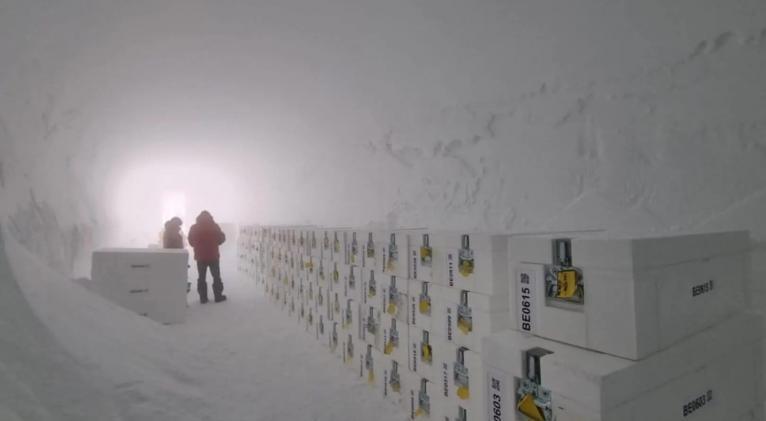Oldest Ice Ever Retrieved Could Hold Key to Earth's Climate History
especiales

For centuries, scientists have searched for clues to Earth’s climatic origins in marine sediments, fossils, and rock formations. Now, a cylinder of ice more than 1.5 million years old, extracted from the frozen heart of Antarctica, has arrived in Europe in an effort to answer one of paleoclimatology’s most puzzling questions: why did the planet's glacial cycles shift pace about one million years ago?
The discovery is part of the ambitious Beyond EPICA – Oldest Ice project, an international scientific initiative that has achieved what until recently seemed impossible. Researchers have drilled to a depth of 2,800 meters in the ice of East Antarctica’s remote Little Dome C. Funded by the European Commission and supported by 12 institutions from 10 countries, the project is not only a technical feat, but also a unique opportunity to redraw the timeline of Earth’s climate history.
Silent Witnesses of a Distant Past
The ice core that arrived this month at the British Antarctic Survey (BAS) in Cambridge is far from an ordinary block of frozen water. It is a one-of-a-kind time capsule, a natural archive preserving in microscopic air bubbles the secrets of Earth’s atmosphere from more than 1.5 million years ago.
Within this core, scientists hope to find concentrations of carbon dioxide, methane, and other gases that dominated the atmosphere during a period known as the Mid-Pleistocene Transition, a pivotal stage in the planet’s climatic evolution. Until now, the oldest ice cores dated back about 800,000 years. This new sample nearly doubles that temporal boundary.
But it is not only about gases. The ice also contains traces of dust, volcanic ash, microorganisms, and particles that can reveal details about wind patterns, temperatures, and ocean conditions of that ancient era. Researchers will analyze it using a pioneering technique that involves slowly melting the ice to measure the chemical composition of each layer in real time.
A Climate Puzzle Still Unsolved
One of the greatest mysteries in climate science is why Earth's glacial cycles, which followed a 41,000-year pattern for nearly two million years, suddenly changed about one million years ago to a new 100,000-year rhythm. This shift marked a profound transformation in the planet’s behavior and its ecosystems.
Several hypotheses have been proposed, including changes in Earth’s orbit, ocean circulation disruptions, and variations in atmospheric CO₂ levels. However, scientists lacked direct data to confirm any of these theories. The ice cores now being preserved in European laboratories, including BAS, could provide the missing evidence.
The fact that these records come from such a remote and stable location as Little Dome C raises expectations. Situated at more than 3,200 meters above sea level and about 40 kilometers from Concordia Station, this area is known for its extremely old ice that remains largely undisturbed by glacial dynamics. It is considered the ideal place to uncover layers that have remained intact for hundreds of thousands of years.
A Laboratory at the End of the Earth
The Beyond EPICA project has been anything but easy. It required years of planning, state-of-the-art drilling technology, and teams capable of working under extreme conditions, with temperatures plunging as low as minus 60 degrees Celsius. Ice extraction campaigns were carried out over multiple seasons, culminating in the fourth expedition and the transport of the cores to the United Kingdom.
Now, a new phase begins in the lab: the meticulous analysis of each sample. Sections of the ice are melted millimeter by millimeter, releasing ancient air bubbles that allow scientists to measure the proportion of trapped gases and particles. This task will continue for years and is expected to produce the most detailed climate chronology ever obtained from ice.
The implications of this work are not merely historical. Understanding how the climate responded to specific gas concentrations over a million years ago could offer critical insight into what lies ahead, especially now that CO₂ levels have returned to values not seen since that time.
In fact, one of the main goals of the project is to compare ancient data with current climate models. If the planet experienced similar greenhouse gas levels during the Mid-Pleistocene Transition but displayed different climate behavior, what other factors might be influencing today's trajectory?
Beyond the Ice
The importance of ice cores extends beyond the scientific realm. They are a tangible link to a world that existed long before humans walked the Earth, a testimony to eras when continents had different shapes, oceans held different depths, and the skies were composed of different gases.
This discovery also serves as a warning. To understand the planet's future, we must look deep into its past. Few tools offer such precision as Antarctic ice, a natural archive that has endured every known cataclysm.
The journey of Earth's oldest ice is only beginning. But its ultimate destination may be the most important of all: helping humanity anticipate the changes that lie ahead, before it is too late.














Add new comment